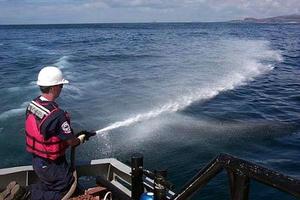Gulf of Mexico oil spillHow safe are the Gulf oil dispersants?
As of 14 June, more than 3.34 million liters of dispersant had been sprayed onto oil on the sea surface; at least a further 1.52 million liters had been pumped into the oil gushing from the stricken well some 1,500 meters below sea level; the use of such large volumes at depth is unprecedented, and marine biologists are concerned about possible toxicity to organisms, including shrimp and fish larvae

Small scale application of oil dispersant // Source: noaa.gov
As arguments continues over how to clean up the Deepwater Horizon oil spill, an examination of toxicity tests reveals flaws in the data used to determine the safety of dispersants.
The U.S. Environmental Protection Agency (EPA) and BP have locked horns over the toxicity of the dispersants being used to break up the oil spewing from the Deepwater Horizon well. Now, New Scientist has learned that a very large variability in the safety test results submitted by different manufacturers makes it difficult to judge which of the available dispersant chemicals poses the least threat to marine life.
“It screams to me that I can’t make a judgment on any of these data,” says Carys Mitchelmore, a toxicologist at the University of Maryland’s Chesapeake Biology Laboratory in Solomons, and co-author of a 2005 National Research Council report on the use of oil dispersants.
The EPA commissioned a new round of tests in late May, but it remains unclear when these will be completed.
BP vs. EPA
So far BP has used a dispersant called Corexit EC9500A made by Nalco Energy Services of Sugar Land, Texas. On 20 May, however, the EPA ordered BP to find a less toxic alternative.
The company quickly responded, stating that only five dispersants met the EPA’s requirements. Only one, called Sea Brat #4, made by Alabaster of Pasadena, Texas, was stockpiled by BP. This contained a chemical that would degrade into nonylphenol; this is a hormone disrupter likely to harm the reproductive systems of marine organisms. “BP continues to believe that Corexit EC9500A remains the best alternative,” the company concluded.
Aldhous writes that since then, there has been an uneasy stand-off, with the EPA telling BP on 26 May to stop surface spraying, and limit its subsea use of dispersant to a maximum of some 57,000 liters on any given day.
Toxicity tests
However, a close examination of the EPA’s Web site
